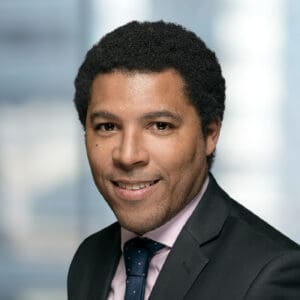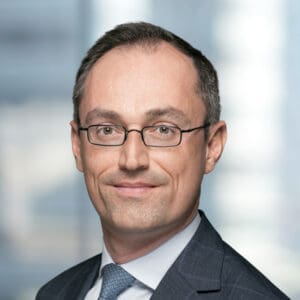What are the key drivers behind asset managers’ move towards multi-asset trading and what benefit can this provide?

Stephane Marie-Francoise
Marie-Francoise: Everything starts with the desire from the investment team to develop a multi-asset class strategy offering. From that point, you can decide if you want to build an infrastructure and a scalable trading platform across the business line – harmonising the workflow and automation – or to externalise. If you think that you will have the volume and the capability to trade across the multi-asset class internally, you will take this road and will choose to build the infrastructure. This gives you flexibility to be able to trade across multi-asset classes internally, asset managers can adapt their strategies and take advantage of market trends or mitigate risks. At Unigestion, for example, we took this road seven years ago when we integrated a multi-asset team.
Champenois: To add, one needs to consider the size of the business. Multi-asset trading desks are much more appropriate for small- to medium-sized organisations as you often operate with smaller teams and trading flows. This makes the multi-asset trading setup easier to implement compared to larger institutions running several 100 billions of US dollar assets under management.
What are the key challenges associated with operating as a multi-asset trading desk?

Eric Champenois
Champenois: As you can imagine, it takes some time and requires a lot of IT development resources, with significant costs attached to that. One needs to have a proper budget to be able to implement such a setup. It’s also a challenge to harmonise the workflows and to select the right trading system for the right asset.
There are also some impacts from a human standpoint as it requires a change of trader skillset. Historically, at Unigestion, we were much more focused on equity trading, and when we took the shift to a multi-asset trading model, traders had to get up to speed on the trading of a wide range of new financial instruments. There is therefore a learning curve that can take some time depending on the complexity of the investment strategies and the underlying instruments.
The adaptation to market standards can also be challenging because not all the instruments are trading the same way and this brings some more complexity when setting up harmonised trading workflows. As an example, electronic trading and automation on equities is a well-established workflow in the industry, whereas some other asset classes such as interest rate OTC derivatives are much more traditional in terms of the way they trade, although some progress has been achieved in the last few years, especially with clearing and in light of electronification.
The last challenge is more from a risk and compliance perspective. You need to be able to understand the strength of each counterpart, because a broker might be good in one asset class but not in the others. It is important to understand all the compliance or regulatory factors because the pragmatics are clearly different between the asset classes.
How can signals in one asset class have implications across other assets?
Champenois: Signals in one asset class often have implications across other assets due to various interconnected factors in the financial markets. Macroeconomic data, investor sentiment, market dynamics and geopolitical events can influence these factors. The impact can obviously vary depending on the context. Having a multi-asset trading desk gives a clearer overview of the interaction between all these instruments and adds value to the investment process.
From a technological point of view, and as previously mentioned, there is a lot of maturity in certain asset classes such as equities. There’s always a wish to reproduce a very streamlined STP workflow, like from equities for example, and to bring it to other asset classes to make it easier to trade, as well as to streamline the process behind the trade. Essentially, trying to reproduce this kind of model. However, the technological capabilities for some instruments are not growing as fast as we at Unigestion would like. Here, for example, equity trading is 100% STP, with listed F&O, foreign exchange and cash bonds the same, and for some other remaining asset classes we still have some manual processes in place. We do our best to streamline all these processes when suitable technology becomes available and ensure that we can at some point get full automation and a scalable environment.
How can multi-asset teams help identify risks and build tools to access greater outcomes?
Champenois: Mitigating operational risk is core for a trading desk. Building STP workflows and ensuring execution velocity is a priority to minimise risk. At Unigestion, it has really been a core focus and it has always been part of our corporate DNA – we want to make sure that we have a good assessment of risk at all times. As a trading desk, we ensure that automation is part of our processes as far as possible. We also need to ensure that the platform is scalable. If you have a proper multi-asset trading desk in place, you should be able to handle all asset classes and automate processes as much as you can so that you can easily grow your business without necessarily growing your structure massively.
Transaction Cost Analysis (TCA) also helps us minimise risks from a cost perspective as it gives better visibility and transparency on implicit costs from an investment perspective but also allow us to better assess our brokers. Thanks to those types of tools, traders can monitor execution costs (in real-time and post-trade), meet compliance requirements and adjust trading strategies if needed to improve portfolio implementation.
How are firms adapting their working practices to compete with the tech industry and attract top talent?
Marie-Francois: Fintech companies are the place where the young talent tends to go to because I would say the work style is seen as more attractive. Traditional finance or asset management doesn’t have the same traction it had 10 or 20 years ago, so our industry needs to adapt to that if it wants to attract the best talent. Covid helped in a certain way, with greater flexibility, but the industry probably needs to do more.
Secondly, high-tech companies are more innovative by nature, giving employees a deeper sense of purpose. There’s a lot of freedom for young talent to create applications and to do some individual work which they are recognised for. Also, financial companies need to convince prospective employees that they can have a positive impact on the world in the future. Finally, from a career growth perspective as well, finance companies need to reinvent themselves to provide new projects and new outcomes for young talent, so they can have long-term views on their future career. If you give long-term projects, young talent is more likely to stay committed to the firm.
What sort of tech innovations are helping facilitate the shift to multi-asset trade?
Marie-Francoise: Innovation is definitely coming from the traditional third-parties, such as the EMS and OMS providers. They started this process a couple of years ago with algo wheels, making life easier for traders to focus on important trades. They keep going into this path by innovating and trying to make their EMS or OMS more multi-asset. A couple of players are doing this quite well, although they are at the stage where they are multi-asset, just as a staging point. A trader can see everything in one place, but they still need to have the other software to execute other asset classes.
The second one comes from fintech companies, in terms of interoperability. They actively try to make the bridge between the different software by asset class and to make it simple for the user. Finally, the last part comes from the exchanges themselves. They try to bring more volume and activity to the listed venues in order to increase transparency by asset classes.